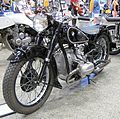Retro design

Retrodesign (lat. Retro backwards, lat. Designare (be) to draw) is a style of design for products in which design elements (colors, shapes, symbols, materials) from bygone times are reused. The retro design comes in two forms. On the one hand, it can be design that already existed in today's design form, on the other hand, with characteristic old elements, the memory of a product of bygone times can be awakened. Even the most innovative products, such as new car models, are given a retro design for marketing or other reasons.
Retro design in automotive engineering
Retro design in automobile design is based on typical body shapes of earlier eras. This design trend developed in the early 1990s and resulted in almost all automobile brands launching models that formally related to cars of the 1950s and 1960s.
Retrodesign mostly cites entire vehicles, often classics of automotive design . Other forms of adopting classic style elements are the Revival Cars and the New Classic Design . Technically, retro cars can deviate significantly from the concept of their historical models.
As early as 1961, the American designer Virgil Exner was using elements of classic automobile design for the new models of Chrysler's top brand Imperial . The 1961 Imperial wore free-standing headlights, and the sides of the cars were given a chrome strip that mimicked the line of curved fenders. Exner later transferred the concept to the newly founded Stutz Motor Car of America brand , whose 1973 Blackhawk III model is known in the USA as the Revival Car . The 1980 Cadillac Seville quotes the Hooper rear end of the 1950s and the 1983 Lincoln Mark VII had a suggested spare wheel bulge in the trunk lid.
Retro design reached its first high point with the Mazda MX-5 , which from 1989 to 1998 was almost a copy of the Lotus Elan from 1962 and is considered the first newly designed roadster in decades. In the years 1989 to 1991 Nissan also produced the retro design Nissan Pao , Nissan Figaro and Nissan S-Cargo in small series. In Japan, retro packages for various small car models have also been popular since the 1990s (for example for the Daihatsu Mira or the Subaru Vivio ). The success of retro design in Japan is also due to the kawaii aesthetic there. In 1994 a retro version of the VW Beetle was presented as a study " VW Concept 1 " at the Detroit Motor Show . Since the reactions of the trade fair visitors were positive, the study was launched in 1998 as a New Beetle based on the Golf IV and without the typical Beetle rear engine . In Europe, this is considered the beginning of the retro wave, which continues to this day with the Jaguar S-Type , 2000 with the Mini , 2007 with the Fiat 500 and 2009 with the Mercedes-Benz SLS AMG . American examples of retro design are the Plymouth Prowler in the style of a hot rod , the Chrysler PT Cruiser modeled after the 1930s sedans and the Ford Thunderbird from 2003. J Mays is a major designer of retro cars . According to experts, retro design has brought back the emotionality in automotive design. At the beginning of the 2000s, retro design evolved into New Classic Design . Vehicles like the Lancia Thesis consist of a mixture of classic and modern design elements without citing a specific historical vehicle.
gallery
Lotus Elan from 1974
Mazda MX-5 from 1989
Gutbrod Superior from 1954
Nissan Figaro from 1991
Chrysler Airflow from 1934
Chrysler PT Cruiser from 2000
Fiat 500 from 1957
Fiat 500 from 2007
Mini from 1963
Mini from 2014
Jaguar S-Type from 1966
Jaguar S-Type from 2001
Ford Thunderbird from 1957
Ford Thunderbird from 2003
Mercedes-Benz 300 SL from 1954
Retro design in motorcycle construction
Retro design is also increasingly used in motorcycle construction . The Triumph Bonneville T120 is based on the design of the 1960s, or the planned BMW R 18, the BMW R 5 from 1936. Almost all well-known manufacturers have motorcycle models with a classic look in their range.
1962 Triumph Bonneville
Triumph Bonneville T120 from 2017
Yamaha XV 1900 A Midnight Star from 2006, based on Harley-Davidson of the 1950s
literature
- Markus Caspers : designing motion, automobile designer from 1890 to 1990, Basel 2016
- Paolo Tumminelli: Car Design Europe, Myths, Brands, People, Kempen 2011
Individual evidence
- ↑ Markus Caspers: designing motion, Automobildesigner from 1890 to 1990, Basel 2016, p. 59f
- ↑ https://www.heise.de/autos/artikel/Abgekupfert-Retro-Autos-und-ihre-historischen-Vorbilder-843581.html
- ^ Paolo Tumminelli: Car Design. teNeues, 2004, ISBN 9783823845614 , p. 98
- ↑ Thorsten Firlus: Autodesign: The mysterious charm of retro cars. In: Zeit Online. March 19, 2012, accessed January 30, 2018 .
- ↑ https://www.heise.de/autos/artikel/Abgekupfert-Retro-Autos-und-ihre-historischen-Vorbilder-843581.html
- ^ Langworth: Encyclopedia of American Cars 1930-1980, p. 389.
- ↑ Thorsten Firlus: Autodesign: The mysterious charm of retro cars. In: Zeit Online. March 19, 2012, accessed January 30, 2018 .
- ^ Paolo Tumminelli: Car Design. teNeues, 2004, ISBN 9783823845614 , p. 78
- ^ Paolo Tumminelli: Car Design. teNeues, 2004, ISBN 9783823845614 , no page number
- ↑ Thomas Geiger, Marco Dalan: Retro-Design: Why new cars like to look old so much. In: welt.de . September 21, 2007, accessed October 7, 2018 .
- ^ Paolo Tumminelli: Car Design. teNeues, 2004, ISBN 9783823845614 , p. 78
- ^ Paolo Tumminelli: Car Design. teNeues, 2004, ISBN 9783823845614 , p. 98
- ↑ BMW project R18 - analogue statement. In: focus.de. May 27, 2019, accessed July 9, 2019 .






















